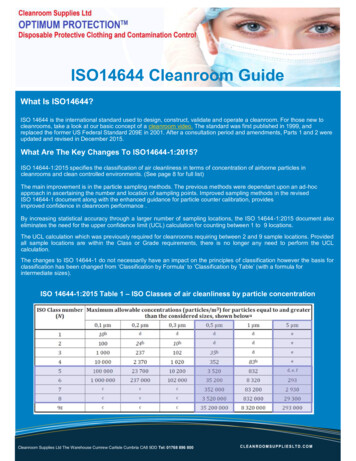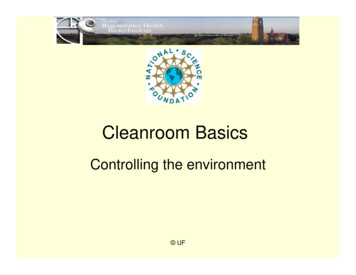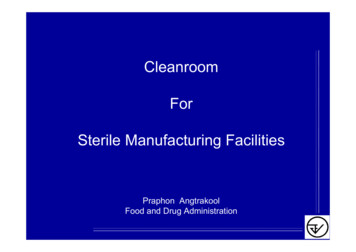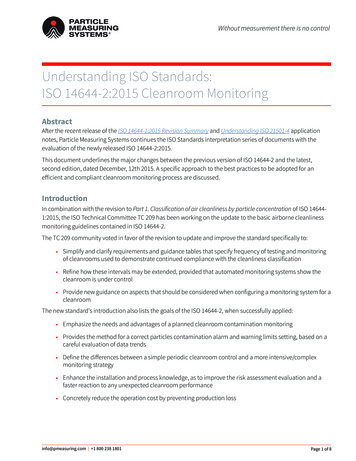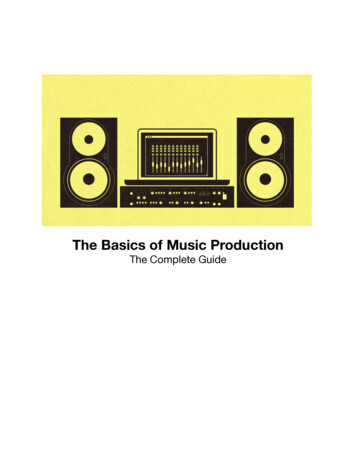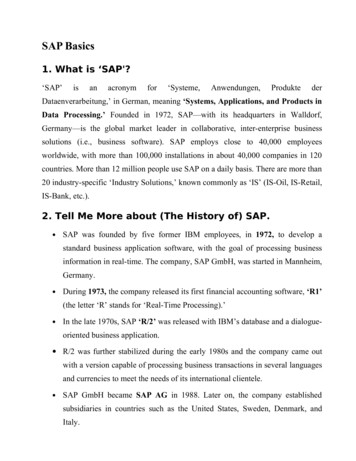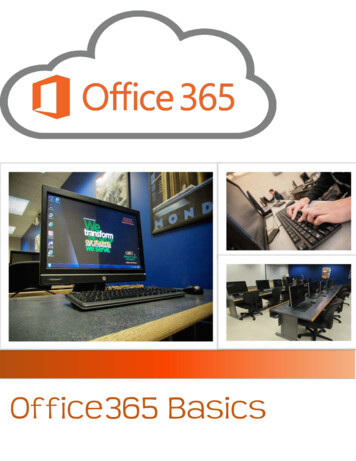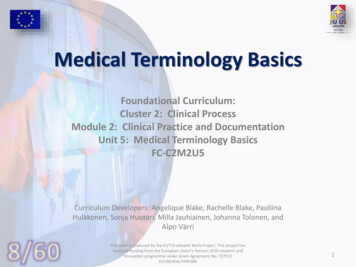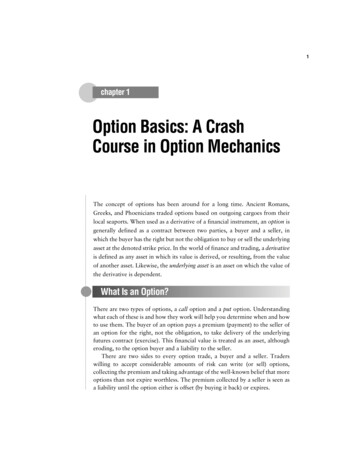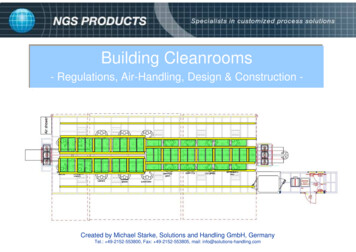
Transcription
Building Cleanrooms-- Regulations,Regulations, Air-Handling,Air-Handling, DesignDesign && ConstructionConstruction --Created by Michael Starke, Solutions and Handling GmbH, GermanyTel.: 49-2152-553800, Fax: 49-2152-553805, mail: info@solutions-handling.com
Contents of Presentation:1. What is a Cleanroom – Basics2. Air-Handling Concepts & Devices3. Cost and efficiency of Air-Handling devices4. De-Centralized Air-Handling concepts & FFU‘s5. Cleanroom Design- Avoiding Contamination- Walls, Ceiling, Floor- Work-Flow- Monitoring etc.13.12.2009, Solutions and Handling GmbH2/55
1. What is a Cleanroom?A clean area, that is designed to reduce the contaminationof processes and materials.This is accomplished by removing or reducingcontamination sources.That means clean air, stable temperature, stable humidity,clean water, gases and chemicals, lighting,processing- equipment, inspection and testequipment, room infrastructure, etc.13.12.2009, Solutions and Handling GmbH3/55
1. What is a Cleanroom?ParticlesContamination Sources: 13.12.2009, Solutions and Handling GmbHPeopleVentilationRoom StructureEquipment 75% 15% 5% 5%4/55
1. What is a Cleanroom?Primary Sources Exposed Skin/Hair / PeopleNon-cleanroom PaperGarmentsVinyl, PVC, Rubber, InkOperations: drilling, 2009, Solutions and Handling GmbHParticlesSecondary Sources GlovesToolsWork SurfacesFloor5/55
1. What is a Cleanroom?ParticlesExamples:13.12.2009, Solutions and Handling GmbH6/55
1. What is a Cleanroom?ParticlesExamples: Particles as small as 1 micro-meter (micron) 0,0000001m The unaided eye can see particles as small as 50 microns on a goodbackground The thickness of a human hair is 100 microns Time to fall 1 meter in still air for a 10 micron particle is 33 seconds, for a 1micron particle is 48 minutes Humans generate 1x105 particles per minute when motionless (fullygowned) Humans can generate 1x106 particles when walking in the Cleanroom13.12.2009, Solutions and Handling GmbH7/55
1. What is a Cleanroom?Cleanroom Standards:ISO 14644 / GMP / DIN / WHO / BS5295 / JIS B9920 etc.Example: Fed-Std. 209E13.12.2009, Solutions and Handling GmbH8/55
1. What is a Cleanroom?Cleanroom Standards:Example: Fed-Std. 209EFS209E requires 10 sample locations, 19.6 liter minimum sample volume(0.85 cf), and a sample time of 51 seconds. This yields a total minimumsample time of 510 seconds and 10 equipment moves.ISO 14644-1 requires 5 sample locations, 19.6 liter minimum samplevolume (0.85 cf ), but also a minimum sample time of one minute yieldingthree samples of one cubic foot. This yields a total sample time of 180seconds and three equipment moves.13.12.2009, Solutions and Handling GmbH9/55
1. What is a Cleanroom?The manufacturing environment is critical for product quality.Factors to be considered include: LightTemperatureRelative humidityAir movementParticulate contamination Uncontrolled environment can lead to poor product quality loss of product and profit13.12.2009, Solutions and Handling GmbH10/55
1. What is a Cleanroom?Parameters influencing the Cleanroom class: Number of particles in the air or on surfacesNumber of air-changes for each roomAir velocity and airflow patternFilters (type, position)Air pressure differentials between roomsTemperature, relative humidityFacility Layout and Work-FlowPart of the Solution:Air-Filtration-Systems, Air-Conditioning-Systems13.12.2009, Solutions and Handling GmbH11/55
2. Air Handling Concepts & DevicesCleanroom Classdefined byCritical ParametersAir HandlingSystem13.12.2009, Solutions and Handling GmbHAdditional Measures12/55
2. Air Handling Concepts & DevicesTools to help achieve the desired Level ofProtectionAir HandlingSystemSupplyAir13.12.2009, Solutions and Handling GmbHProduction RoomWithDefinedRequirementsOutletAir13/55
2. Air Handling Concepts & Devices13.12.2009, Solutions and Handling GmbH14/55
2. Air Handling Concepts & DevicesUDA Unidirectional Air-Flow13.12.2009, Solutions and Handling GmbH15/55
2. Air Handling Concepts & Devices13.12.2009, Solutions and Handling GmbH16/55
2. Air Handling Concepts & DevicesCentralized Air-Conditioning System:13.12.2009, Solutions and Handling GmbH17/55
2. Air Handling Concepts & DevicesDe-Centralized System: Air-Conditioning in combination with Fan Filter Units13.12.2009, Solutions and Handling GmbH18/55
2. Air Handling Concepts & DevicesDe-Centralized System: Fan Filter Units & Coolingapprox. 8% off-air13.12.2009, Solutions and Handling GmbHapprox. 10% outside air19/55
2. Air Handling Concepts & DevicesDe-Centralized System: Fan Filter Units & Cooling13.12.2009, Solutions and Handling GmbH20/55
3. Cost and Efficiency of Air-Handling SystemsIn regard to the design and use of an Air-Handling System, the following aspects need tobe considered. Cleanroom conform realisation of production areas with a focus on contaminationsources and safety aspects. Modular Cleanroom concepts for future changes and maintenance work. Independent supply systems (HVAC) Low investment cost, a good price- / product-ratio, avoiding falsely placedinvestments. Low running- and maintenance-cost13.12.2009, Solutions and Handling GmbH21/55
3. Cost and Efficiency of Air-Handling SystemsCleanroom projects can be divided into three groups:Cleanrooms that are being integrated into existing buildings by using the givenbuilding structure. The air-handling concept is almost always linked to the existingHVAC concept.Integration of a Room-in-Room solution into an existing building with anindependent air-handling system.Cleanroom concept that is being designed and built together with a new building.13.12.2009, Solutions and Handling GmbH22/55
3. Cost and Efficiency of Air-Handling SystemsIn a first planning phase is important to analyze the needs of a customer and to comparethe requirements to the currently used Cleanroom / production process. Often only small areas of the production have to be classified clean areas.Most important it is to find the sources of contamination and to analyze how they can becontrolled or avoided. The biggest source of contamination is often people working within the Cleanroom.Proper clothing, Cleanroom “etiquette” training and discipline help to keep the levels low.At the same time it is needed to create a scheme of cascaded room pressures.having the highest air-pressure within the room of the highest class all the way to thepressure into the “grey” or “black” areas with no classification. Thuslowest or no over-Large areas of filter covered ceiling should be avoided for cost reasons,- “bay-solutions”are more cost-efficient. Design of the Air-Handling system13.12.2009, Solutions and Handling GmbH23/55
3. Cost and Efficiency of Air-Handling SystemsThe temperature difference between conditioned air and re-circulated air needs to be asbig as possible. This allows the amount of conditioned air versus the non-conditioned (re-circulated) air to be small.Heat-exchange systems might also prove to be an additional means of lowering therunning cost of a Cleanroom facility.De-centralized Air-Conditioning (AC) units are more and more becoming an option thatnot only allows independence from existing building installations, but also in regard totheir modularity, maintenance and price.Short distances between the Cleanroom and the AC-system avoid pressure drops withinthe system.13.12.2009, Solutions and Handling GmbH24/55
3. Cost and Efficiency of Air-Handling SystemsFurther into the planning process low air-exchange rates need to be realized.Sections of high heat-emission have to be separated from the Cleanroom area. Thishelps to keep the amount of cooling low and saves energy too.Air-speed under the ceiling can be lowered in certain areas,- achieving the sameCleanroom class by saving on filter media and energy cost.Finally, the air-handling concept needs to be defined. The best results have so called “return-air” systems. Here 80% (or so) are being recirculatedto the Cleanroom, whilst 10-20% of the air are being conditioned via an AirConditioning system and/or areoutside air.13.12.2009, Solutions and Handling GmbH25/55
3. Cost and Efficiency of Air-Handling SystemsThe energy use of Cleanroom environmental systems varies with the systemdesign, Cleanroom functions and critical parameter control including filtration,temperature and humidity.“ A review of studies on Cleanroom operation costs indicated that energy costcould amount to 65 – 75% of the total annual cost associated with Cleanroomoperation and maintenance ” (LBNL-51549, Contamination Control Society)Comment:- Energy cost- Cost of a Cleanroom- Investment cost HVAC13.12.2009, Solutions and Handling GmbHC 350 - . depending on class and systemC 800 - . Depending on class and system26/55
3. Cost and Efficiency of Air-Handling SystemsCost of Cleanrooms, without AC-System, walls and flooring(Source: Dipl. Ing. W. Gerk, KI, 2003)13.12.2009, Solutions and Handling GmbH27/55
3. Cost and Efficiency of Air-Handling SystemsCost for Cleanroom Modules, based on the supply-air concept, without AC-System, wallsand flooring.Type (values per m² Cleanroom):Supply-Air velocitySupply-Air VolumeReturn-Air VolumeOutside-Air VolumeEfficiency of AC-UnitAir-Differential Pressure AC-UnitEfficiency of Fan-MotorTotal Air-Pressure difference of FanEnergy Consumption(Energy ergy Saving from motors/fans:0,187W x 8760h/a x 0,092 approx. 150,00/aEnergy Saving (electrical) for Cooling: 0,187W x 0,33 (eff.) x 8760h/a x 0,092 approx. 50,00/aTotal amount of energy savings per m² Cleanroom and year: approx. 200,00/a(values based on projects sized 200m² - 1.000m², Dipl. Ing. W. Gerk, KI, 2004)13.12.2009, Solutions and Handling GmbH28/55
3. Cost and Efficiency of Air-Handling SystemsThe types of recirculation systems, design details, and layout, can largely affect themagnitudes of overall air system efficiency.The bottom line is that reducing resistance in the air path throughout air systems canlower pressure drops, and thus require less fan power and energy to re-circulatethe air needed to maintain effective contamination control.(Excerpt taken from: Airflow Design for Cleanrooms and its Economic Implications, by Tengfang Xu, Ph.D., PE, LawrenceBerkeley National Laboratory, 2007)Amongst other aspects, the following issues are important as well. Optimizing exhaust flows on toolsLowering cleanroom airflow through HEPA filtersMeasuring key tools to optimize heat removal13.12.2009, Solutions and Handling GmbH29/55
4. De-Centralized Air Handling Concept – FFU’sExample of a Cleanroom with different Zones:13.12.2009, Solutions and Handling GmbH30/55
4. De-Centralized Air Handling Concept – FFU’sExample of a Cleanroom with different Zones:13.12.2009, Solutions and Handling GmbH31/55
4. De-Centralized Air Handling Concept – FFU’sExample of a Cleanroom with different Zones:13.12.2009, Solutions and Handling GmbH32/55
4. De-Centralized Air Handling Concept – FFU’s3-D view of aCleanroomconstruction13.12.2009, Solutions and Handling GmbH33/55
4. De-Centralized Air Handling Concept – FFU’sIntegration ofFan Filter Units13.12.2009, Solutions and Handling GmbH34/55
4. De-Centralized Air Handling Concept – FFU’sIndividual Control of FFU‘s:13.12.2009, Solutions and Handling GmbH35/55
5. Optimizing a Cleanroom Cleanroom DesignAvoiding Contamination / Cleanroom DisciplineMaterial Exchange / Air-ShowersEnclosures for MachineryReducing Power Consumption- Machines / Process- Lighting (T8 / T5 / other lamps) Work-Flow- Storage next to end of production line- Warehouse / Stock centralized13.12.2009, Solutions and Handling GmbH36/55
5. Cleanroom Design: Wall Systems Ceiling Systems Flooring Doors & Windows Control Systems- Light- Interlock- Monitoring etc.13.12.2009, Solutions and Handling GmbH37/55
5. Cleanroom Design: Walls Systems-Mono-Block Systems:One block wall sytem, 50 or 60mm thickness, surfacepowder coated steel, joints often covered with silicone.Panel core mineral wool, polyurethane or honey-combe.These walls types often are used for pharmaceuticalCleanrooms. Heavy duty construction, more for fixedroom layouts.13.12.2009, Solutions and Handling GmbH- Modular Wall Systems:Singles shell or double shell framed wall systems.Modular structure with glass, aluminium or other type panels.Ideal for semiconductor applications, as the Cleanroom canbe easilly adapted to production layout changes.38/55
5. Cleanroom Design: Mono-Block Systems13.12.2009, Solutions and Handling GmbH39/55
5. Cleanroom Design: Mono-Block SystemsAdvantages:Dis-Advantages:-Insulation properties- Higher in price-Solid structure- Not easy to change room layout-Smooth surface and joints- Integration of horizontal ducts-Use in high Cleanroom classes13.12.2009, Solutions and Handling GmbH40/55
5. Cleanroom Design: Modular Systems13.12.2009, Solutions and Handling GmbH41/55
5. Cleanroom Design: Modular Systems13.12.2009, Solutions and Handling GmbH42/55
5. Cleanroom Design: Modular SystemsAdvantages:Dis-Advantages:- lower in price- Reduced insulation properties- modular, easy to change- Suface flush, but with joints- Integration of horizontal ducts - Less load bearing-Use in high Cleanroom classes13.12.2009, Solutions and Handling GmbH43/55
5. Cleanroom Design: Wall Systems13.12.2009, Solutions and Handling GmbH44/55
5. Cleanroom Design: Room-in-Room structures13.12.2009, Solutions and Handling GmbH45/55
5. Cleanroom Design: Monitoring Systems13.12.2009, Solutions and Handling GmbH46/55
5. Avoiding Contamination:13.12.2009, Solutions and Handling GmbH47/55
5. Avoiding Contaminati
Cleanroom concept that is being designed and built together with a new building. Integration of a Room-in-Room solution into an existing building with an independent air-handling system. 13.12.2009, Solutions and Handling GmbH 23/55 3. Cost and Efficiency of Air-Handling Systems In a first planning phase is important to analyze the needs of a customer and to compare the requirements to the .
